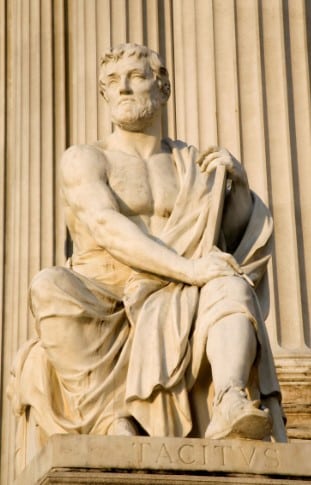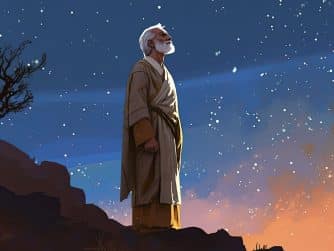I write this article in response to a documentary I recently watched from the UK in which a so-called, “religious expert” had stated in a publicly televised debate, “there was no evidence that Jesus Christ ever existed.” This wasn’t ‘Brexit’ but apparently the complete exit of Jesus from the history books! Frankly, I nearly fell off my chair upon hearing this false claim.
Let me repeat, this woman denied that Christ ever existed at all, which is definitely a counterfactual statement rooted in either ignorance at best or perhaps nefarious Gnosticism at the very worst (1 Jn 4:3). It’s not enough to deny Christ as Savior, now they are denying He ever existed! Despite numerous so called ‘Christians’ being present in this debate, I was most perturbed that not one of them confronted her about this. Don’t get me wrong, I’m all for education but we shouldn’t educate ourselves at the expense of common sense.

I will say up front, only a fool would claim that Jesus Christ never existed on this earth. I’m not saying this because I’m a Christian, but most secularists will concur with the documented evidence of Christ’s existence. There’s a wealth of independent historical and textual evidence that Jesus existed outside the Canon of Scripture (which I will reveal shortly). Those who dispute this fact have not done their homework. The Apostle Peter warned of such absurd claims in these last days, 3 “Knowing this first, that there shall come in the last days scoffers, walking after their own lusts.4 And saying, Where is the promise of his coming? for since the fathers fell asleep, all things continue as they were from the beginning of the creation” 2 Peter 3:3-5 (KJB).
De-nial is not a river in Egypt…
Not only are these ‘scoffers’ currently in denial of Christ’s imminent return, but apparently some of them flat out repudiate He ever existed in the first place! Scholars have debated this issue down the years and to dispel any partiality, the focus of this article will be on extra-Biblical evidence for Christ’s existence i.e., outside of the Bible. As a result, the consequent findings of this article will be palatable for non-Christians also, leading to the inevitable and obvious conclusion that Jesus’s existence is a documented fact. Christ’s historical notability should never come into question. It has been assuredly verified by independent observers being mutually exclusive to Christianity.
The focus of our research to substantiate Christ’s earthly existence will be the Greco-Roman historical source texts in addition to the Jewish historical narrative. Historical evidence is derived primarily from historical examination of archeological artifacts, which include primary and secondary source manuscripts (of which there are an abundance). It’s absurd to hold a viewpoint that the New Testament writings (which are by far the most reliable ancient writings in existence today) do not lend credibility to Christ’s existence. To do so would invalidate the credibility of many other accepted historical documents which have far fewer copies in existence. I am thankful to Dr. Lawrence Mykytiuk for his scholarly work, providing a thorough review of these extra biblical sources as insurmountable evidence of Christ’s incarnation as a man who walked the earth, two millennia ago.
Extra Biblical Sources: 7 documented witnesses to Christ’s existence
1) Publius Cornelius Tacticus (a Roman senator and historian) provided an account from the reign of Tiberius to Nero (14-68 A.D.). He shows evidence of Jesus when he wrote a biography of the Emperor Nero in 64 AD:
“Neither human effort nor the emperor’s generosity nor the placating of the gods ended the scandalous belief that the fire had been ordered [by Nero]. Therefore, to put down the rumor, Nero substituted as culprits and punished in the most unusual ways those hated for their shameful acts … whom the crowd called “Chrestians.” The founder of this name, Christ [Christus in Latin], had been executed in the reign of Tiberius by the procurator Pontius Pilate … Suppressed for a time, the deadly superstition erupted again not only in Judea, the origin of this evil, but also in the city [Rome], where all things horrible and shameful from everywhere come together and become popular.“
Publius Cornelius Tacticus

2) Titus Flavius Josephus was a first century urbane Romano-Jewish scholar, historian and hagiographer, born in Jerusalem (37 A.D. -100 A.D.). The Roman historian Josephus mentioned Christ several times while relating noteworthy civic events, including the execution of one named “James, the brother of Jesus who was called the Christ/Messiah,” referring evidently to Jesus’ brother James, leader of the early church and author of the New Testament book bearing his name. This cosmopolitan historian whose two great works, The Jewish War and Jewish Antiquities written in Greek, also mentions Jesus in his writings:
“Being therefore this kind of person [i.e., a heartless Sadducee], Ananus, thinking that he had a favorable opportunity because Festus had died and Albinus was still on his way, called a meeting [literally, “sanhedrin”] of judges and brought into it the brother of Jesus-who-is-called-Messiah … James by name, and some others. He made the accusation that they had transgressed the law, and he handed them over to be stoned.”
Titus Flavius Josephus

The longer passage in Josephus’s Jewish Antiquities (Book 18) referring to Jesus is known as the “Testimonium Flavianum” and reads as follows:
“Around this time there lived Jesus, a wise man, if indeed one ought to call him a man. For he was one who did surprising deeds, and a teacher of such people as accept the truth gladly. He won over many Jews and many of the Greeks. He was the Messiah. When Pilate, upon hearing him accused by men of the highest standing among us, had condemned him to be crucified, those who in the first place came to love him did not give up their affection for him, for on the third day, he appeared to them restored to life. The prophets of God had prophesied this and countless other marvelous things about him. And the tribe of Christians, so called after him, have still to this day not died out.”
Titus Flavius Josephus
3) Lucian of Samosata (c. 115–200 A.D.) was a Greek satirist who wrote The Passing of Peregrinus, about a former Christian who later became a famous cynic and revolutionary who died in 165 A.D. In two sections of Peregrinus (here translated by Craig A. Evans) Lucian, while discussing Peregrinus’s career, without naming Jesus, clearly refers to him, albeit with contempt in the midst of satire:
“It was then that he learned the marvelous wisdom of the Christians, by associating with their priests and scribes in Palestine. And— what else?—in short order he made them look like children, for he was a prophet, cult leader, head of the congregation and everything, all by himself. He interpreted and explained some of their books, and wrote many himself. They revered him as a god, used him as a lawgiver, and set him down as a protector—to be sure, after that other whom they still worship, the man who was crucified in Palestine because he introduced this new cult into the world.”
Lucian of Samosata

“For having convinced themselves that they are going to be immortal and live forever, the poor wretches despise death and most even willingly give themselves up. Furthermore, their first lawgiver persuaded them that they are all brothers of one another after they have transgressed once for all by denying the Greek gods and by worshiping that crucified sophist himself and living according to his laws.”
Lucian of Samosata
4) Publius Lentulus (Roman Consul during the reign of Augustus) sent a letter to the Roman Senate during the Roman Empire period (he is also said to have been Governor of Judea before Pontius Pilate). Here is an extract from that letter:
“There appeared in these days a man of great virtue, named Jesus Christ, who is yet among us; of the Gentiles accepted for a prophet of truth; but his disciples call him the Son of God. He raiseth the dead, and cureth all manner of disease. A man of stature somewhat tall and comely, with a very reverend countenance, such as the beholder must both love and fear.
His hair the color of a chestnut full ripe, plain to the ears, whence, downward, it is more orient, curling and waving about his shoulders. In the midst of his forehead is a stream or partition of his hair, after the manner of the Nazarites; forehead plain and very delicate; his face without spot or wrinkle, beautiful, with a lovely red; his nose and mouth so forked as nothing can be represented; his beard thick, in color like his hair, not over long; his look innocent and mature; his eyes gray, quick, and clear.
In reproving, he is terrible; in admonishing, courteous and fair-spoken; pleasant in conversation, mixed with gravity. It cannot be remembered that any have seen him laugh, but many have seen him weep; in proportion of body most excellent; his hands and arms delectable to behold; in speaking, very temperate, modest and wise; a man of singular beauty, surpassing the children of men.”
Publius Lentulus
5) The Manuscripts: According to F. F. Bruce a Biblical Scholar who supported the historical reliability of the New Testament, there are nine or ten good copies of Julius Caesar’s Gallic War which survived to this day; twenty copies of Livy’s Roman History, two copies of Tacitus’ Annals, and eight manuscripts of Thucydides’ History. Yet all these men are counted as actual historical figures without refutation. The most documented ancient secular work is Homer’s Iliad, surviving in 643 manuscript copies.
“Counting Greek copies alone and in comparison to other secular works, the New Testament text is preserved in some 5,686 partial and complete manuscript portions which are presently kept in either private collections or museums. This represents an almost nine-fold abundance of NT codices in comparison to the nearest secular work within the same epoch of history!“
F.F. Bruce
These were copied by hand from the second (possibly even the first copy) through the fifteenth centuries. This fact by itself shouldn’t warrant any further discussion concerning Christ’s existence, albeit there is more evidence to reveal from the manuscripts themselves. F.F. Bruce goes on the say:
“Catalogued Greek texts include eighty-eight papyri manuscripts, 274 uncial manuscripts, and 245 uncial lectionaries. Those early uncial manuscript witnesses are extremely valuable in establishing the original text of the New Testament. This is an astounding number and variety. It is not uncommon for classics from antiquity to survive in only a handful of manuscript copies.“
F.F. Bruce

“In addition to the Greek manuscripts there are numerous translations from the Greek, not to mention quotations of the New Testament. Counting major early translations in Syriac, Coptic, Arabic, Latin, and other languages, there are 9000 copies of the New Testament. This makes a total of over 14,000 copies of the New Testament. What is more, if we compile the 36,289 quotations by the early church Fathers of the second to fourth centuries we can reconstruct the entire New Testament minus 11 verses.”
F. F. Bruce
Did you catch that? The fact we can replicate almost the entire New Testament from other sources is frankly astounding and testimony to not only the accuracy but proliferation of these early writings which God promised to preserve.
It doesn’t take a rocket scientist to figure out that if you believe Julius Caesar or the Greek Poet Homer were real people of the ancient past, know that the evidence for Jesus Christ far outweighs either of them. You can’t have it both ways, if you acknowledge other historical figures of antiquity, then you must acknowledge Christ’s existence also. It would be hypocritical to ignore someone’s existence based on one’s own partisan belief system, which chooses to ignore independent historical witnesses as some secular scholars have done. We have to look at the facts objectively; just as Christians accept the existence of Mohammad based on historical accounts, even though we don’t worship the same God.
6) Babylonian Talmud: There are a few clear references to Jesus in the Babylonian Talmud, a collection of Jewish rabbinical writings compiled between 70-500 A.D. Given this time-frame, it’s naturally purported earlier references to Jesus are more likely to be historically reliable than later ones. In the case of the Talmud, the earliest compilation occurred between 70-200 AD. The most significant reference to Jesus from this period states:
“On the eve of the Passover Yeshu was hanged. For forty days before the execution took place, a herald… cried, “He is going forth to be stoned because he has practiced sorcery and enticed Israel to apostasy.”
Babylonian Talmud

Let’s briefly examine this passage from the Talmud. You may have noticed it refers to someone named “Yeshu.” So why do we think this is Jesus? Actually, “Yeshu” (or “Yeshua”) is how Jesus’ name is pronounced in the Hebrew language. But what does this passage mean by saying that Jesus “was hanged”? Doesn’t the New Testament say he was crucified? Indeed, it does. But the term “hanged” can function as a synonym for “crucified.” For instance, Galatians 3:13 declares that Christ was “hanged.” Luke 23:39 also applies this term to the criminals who were crucified with Jesus. So, the Talmud declares that Jesus was crucified on the eve of Passover. But what of the cry of the herald that Jesus was to be stoned? This may simply indicate what the Jewish leaders were planning but were unable to carry out. As we know, Roman involvement changed their plans.
7) New Archaeological Evidence: A new fascinating artifact found in the region of Israel is an ossuary, a medium-sized box in which human bones were placed for permanent burial after the flesh had decayed. This practice was employed for only a brief period of time from about B.C. 20 to A.D. 70. The box is made of a soft, chalky, limestone, common to the area. The contents have long since vanished but most remarkably, an inscription has been etched into the side of the box which reads, “James, son of Joseph, brother of Jesus” in the Aramaic script of the time. Careful studies, including scrutiny under an electron microscope show the inscription to be genuine. The patina, or oxidized surface equally covers both the box and interior of the etched letters. The recognized expert on such matters, Dr. Andre Lemaire, concludes: “I am pleased to report that in my judgment it is genuinely ancient and not a fake.”

All three names used were common in that era, but seldom was the deceased’s brother mentioned, unless that brother was noteworthy. To have all three listed, in correct Biblical relationship certainly supports the possibility of this being the very ossuary of the Apostle James! With or without the ossuary or other archeological evidence, we can still be confident that the biblical accounts of Christ’s life are true.
7 Additional Extra-Biblical witnesses
- Celsus: the Platonist philosopher, considered Jesus to be a magician who made exorbitant claims.
- Suetonius: a Roman writer, lawyer and historian, wrote of riots in 49 C.E. among Jews in Rome which might have been about Christus but which he thought were incited by “the instigator Chrestus.”
- Mara bar Serapion: a prisoner of war held by the Romans, wrote a letter to his son that described “the wise Jewish king” in a way that seems to indicate Jesus.
- Pliny the Younger: a Roman governor and friend of Tacitus, wrote about early Christian worship, in Letters 10:96, recorded early Christian worship practices including the fact that Christians worshiped Jesus as God and were very ethical, and he includes a reference to the love feast and Lord’s Supper.
- Gnostic writings: The Gospel of Truth, The Apocryphon of John, The Gospel of Thomas, The Treatise on Resurrection, etc. all mention Jesus by name although their contents are both heretical and blasphemous.
- Julius Africanus: quotes the historian Thallus in a discussion of the darkness which followed the crucifixion of Christ (Extant Writings, 18).
- Encyclopedia Britannica: uses 20,000 words to tell about Jesus, and never hints that He did not exist. This is more words than the Britannica allows for Aristotle, Alexander the Great, Cicero, Julius Caesar, or Napoleon Bonaparte. H. G. Wells blasphemed Jesus, yet he felt compelled to discuss Jesus on ten pages in his Outline of History and never once questioned Christ’s existence.
In closing, almost all the statements about Jesus, which are asserted in the New Testament, are corroborated or confirmed by the relevant passages in the writings of both Tacitus and Josephus. These independent historical sources (one a non-Christian Roman and the other Jewish), confirm the testimony of the Gospel account.
The following 9 facts can be systematized from Non-Biblical Accounts
- He existed as a man: The historian Josephus grew up in a priestly family in first-century Palestine and wrote only decades after Jesus’ death. Jesus’ known associates, such as Jesus’ brother James, were his contemporaries. The historical and cultural context was second nature to Josephus. “If any Jewish writer were ever in a position to know about the non-existence of Jesus, it would have been Josephus. His implicit affirmation of the existence of Jesus has been, and still is, the most significant obstacle for those who argue that the extra-Biblical evidence is not probative on this point,” Robert Van Voorst observes. And Tacitus was careful enough not to report real executions of nonexistent people.
- His personal name was Jesus, as Josephus informs us.
- He was called Christos in Greek, which is a translation of the Hebrew word Messiah, both of which mean “anointed” or “(the) anointed one,” as Josephus states and Tacitus implies, unaware, by reporting, as Romans thought, that his name was Christus.
- He had a brother named James (Jacob), as Josephus reports.
- He won over both Jews and “Greeks” (i.e., Gentiles of Hellenistic culture), according to Josephus, although it is anachronistic to say that they were “many” at the end of his life. Large growth in the number of Jesus’ actual followers came only after His death.
- Jewish leaders of the day expressed unfavorable opinions about him, at least according to some versions of the Testimonium Flavianum.
- Pilate rendered the decision that he should be executed, as both Tacitus and Josephus state.
- His execution was specifically by crucifixion, according to Josephus.
- He was executed during Pontius Pilate’s governorship over Judea (26–36 A.D.), as Josephus implies and Tacitus states, adding that it was during Tiberius’s reign.
Conclusion
Bertrand Russell, the Welsh philosopher, logician, social reformer, founding figure in the analytic movement in Anglo-American philosophy, and recipient of the Nobel Prize for Literature in 1950, wrote in his essay Why I Am Not a Christian that, “Historically it is quite doubtful whether Christ ever existed at all and if he did, we know nothing about him.”

Sorry Bertrand it looks like you reached your conclusion without sufficient research because clearly the argument is compelling for Christ’s existence, even from non-biblical sources. As believers we should be able to give an account of what we believe and why we believe it, even utilizing outside sources if circumstances necessitate.
No serious scholar has ventured to postulate the non-historicity of Christ although many have tried down the years. We don’t need these extra biblical sources as Christians to confirm what already bears witness in our hearts, namely that Christ was supernaturally born of a virgin, died and rose from the dead.
Hopefully this article proves useful when encountering occasional skeptics who’ve not done their own research regarding, Christ’s well documented and absolutely certain existence.
Have you believed on the Lord Jesus Christ? If not, click here to find out more…
Bibliography:
Annals XV.44, as translated in Van Voorst, Jesus Outside, pp. 42–43.
Jewish Antiquities, XX.9.1 Whiston’s translation, by Meier, Marginal Jew, vol. 1, p. 57.
Encyclopedia of 7700 Illustrations (April 1990) By Paul Lee Tan.
Encyclopedia Britannica (Micropedia & Macropedia Editions) 2009.
Baker Encyclopedia of Christian Apologetics (Nov 1998) By Norman Geisler.
Excerpts from “Bible History Daily” – Dr. Lawrence Mykytiuk – 12/08/2014 (www.biblicalarchaeology.org).
Excerpts from “Is there extra biblical proof of Jesus?” – Jason Bluto – 2013 (https://pleaseconvinceme.blogspot.com)
Excerpts from “Ancient Evidence for Jesus from Non-Christian Sources” – Dr. Michael Gleghorn (Probe Ministries).
Excerpts from “gotquestions.org”- Did Jesus really exist?
John D. Morris, Ph.D. 2002. “Has Archaeological Evidence for Jesus Been Discovered?” Acts & Facts.
Title: Did Jesus really exist?
https://www.biblicalarchaeology.org/daily/people-cultures-in-the-bible/jesus-historical-jesus/did-jesus-exist/
Related keyword searches:





